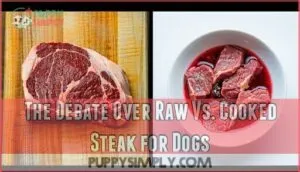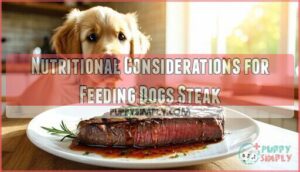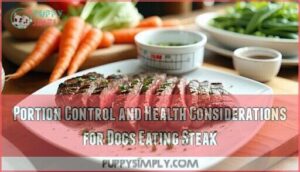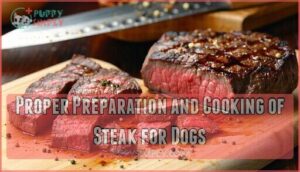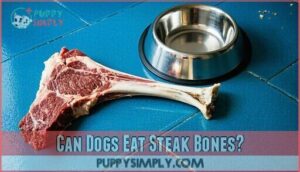This site is supported by our readers. We may earn a commission, at no cost to you, if you purchase through links.

You’ll want to keep portions small—steak should make up no more than 10% of your dog’s daily calories.
Skip the raw meat, as it carries risks of foodborne illness that could leave your pup feeling ruff.
Cook it plain without seasonings, garlic, or onions, which are toxic to dogs.
Well-prepared steak offers excellent protein, iron, and essential nutrients that support muscle development.
Think of it as the ultimate high-value training treat that’ll have your four-legged friend doing backflips.
However, proper preparation and portion control make all the difference between a healthy treat and potential digestive trouble.
Table Of Contents
- Key Takeaways
- Is Steak Safe for Dogs?
- The Debate Over Raw Vs. Cooked Steak for Dogs
- Nutritional Considerations for Feeding Dogs Steak
- Portion Control and Health Considerations for Dogs Eating Steak
- Safe Feeding Practices for Dogs and Steak
- Can Dogs Eat Steak Fat and Trimmings?
- Can Dogs Eat Steak Bones?
- Frequently Asked Questions (FAQs)
- Conclusion
Key Takeaways
- Cook it thoroughly and plain – You’ll need to cook steak completely to kill harmful bacteria like salmonella and E. coli, and skip all seasonings, garlic, and onions that are toxic to dogs.
- Keep portions small and occasional – You should limit steak to no more than 10% of your dog’s daily calories and serve it as an occasional treat, not a meal replacement.
- Remove all fat and bones – You’ll want to trim excess fat to prevent pancreatitis and never give steak bones, as they can splinter and cause choking or internal injuries.
- Consult your vet first – You should check with your veterinarian before adding steak to your dog’s diet, especially if they have existing health conditions or dietary restrictions.
Is Steak Safe for Dogs?
Yes, steak is generally safe for dogs when prepared properly.
You’ll want to cook it thoroughly to eliminate bacterial contamination and avoid steak bones, which can splinter.
Different breeds show varying sensitivity to rich foods, and age factors matter too—puppies and senior dogs need gentler diets.
Consider steak alternatives like chicken or fish if your dog has steak allergies.
Safe cooking methods include grilling or pan-searing without seasonings, oil, or butter.
Remember, moderation is key for dog steak safety.
The Debate Over Raw Vs. Cooked Steak for Dogs
When you’re deciding between raw and cooked steak for your dog, you’ll need to weigh serious health risks against safety benefits.
Raw meat can harbor dangerous bacteria like salmonella and E. coli, while properly cooked steak eliminates these pathogens and aids digestion, providing a clear safety benefit.
The Risks of Raw Meat Diet for Dogs
Raw steak presents significant health risks that responsible dog owners shouldn’t ignore.
Bacterial contamination poses the biggest threat, with studies showing 21-44% of raw chicken and 3.5-4% of raw beef samples containing salmonella.
Your dog might also encounter listeria, E. coli, and other dangerous pathogens that cause serious foodborne illnesses.
Parasite exposure adds another layer of concern.
Raw meat can harbor toxoplasma, trichinella, and other parasites that affect both dogs and humans.
When your pet sheds these organisms, your entire household faces potential infection risks.
Nutritional imbalance becomes inevitable with raw feeding.
Up to 95% of homemade raw diets lack essential nutrients, creating deficiencies that lead to immune suppression and long-term health problems.
Many raw food samples tested positive for harmful bacteria, including salmonella.
| Risk Category | Specific Concerns |
|---|---|
| Bacterial Contamination | Salmonella, E. coli, Listeria |
| Parasite Exposure | Toxoplasma, Trichinella, Echinococcus |
| Nutritional Issues | Calcium, vitamin deficiencies |
| Public Health | Zoonotic transmission to humans |
The public health implications extend beyond your dog, potentially affecting vulnerable family members like children and elderly relatives.
The Benefits of Cooking Steak for Dogs
Cooking steak eliminates harmful bacteria while preserving essential nutrients your dog needs.
Proper preparation guarantees safe cooking and maximum digestibility, making protein, vitamins, and minerals more accessible.
Well-cooked steak offers better palatability than raw meat, encouraging healthy eating habits across different breed needs.
Recent studies show comparable digestibility exists between raw and cooked whole food ingredients.
| Cooking Benefit | Health Impact | Safety Advantage |
|---|---|---|
| Kills bacteria | Prevents illness | Reduces contamination risk |
| Improves digestibility | Better nutrient absorption | Gentler on stomach |
| Enhances palatability | Encourages eating | Appeals to picky eaters |
| Retains nutrients | Maintains steak nutrition for dogs | Preserves steak benefits for dogs |
Nutritional Considerations for Feeding Dogs Steak
While steak offers valuable protein, iron, and omega-6 fatty acids that support your dog’s muscle development and coat health.
It’s vital to understand the proper nutritional balance. Before adding steak to your dog’s diet, consult your veterinarian to confirm it fits their specific health needs and won’t interfere with their regular food, ensuring the right balance for their well-being.
Protein, Iron, and Omega-6 Fatty Acids in Steak
Now that you understand the debate between raw and cooked steak, let’s explore what makes steak nutritionally valuable for your dog.
The protein benefits in steak are impressive, containing all the amino acids your pup needs for muscle development and tissue repair. When your dog munches on properly prepared steak, they’re getting high-quality protein that supports strong muscles and healthy growth.
Iron absorption from steak helps prevent anemia and keeps your dog’s energy levels steady. This mineral plays a key role in oxygen transport throughout their body. Meanwhile, omega-6 sources in steak work behind the scenes to promote coat health, giving your furry friend that shiny, lustrous fur you love to pet.
Steak benefits for dogs extend beyond basic nutrition. The fatty acids support healthy skin, reducing dryness and irritation. However, steak nutrition for dogs works best when it’s part of a balanced diet, not the main course. Think of it as a premium supplement to their regular meals, delivering concentrated nutrition in small, manageable portions that complement their overall dog nutrition plan.
Consulting a Vet for Dietary Recommendations
Before diving into dietary changes, getting veterinary advice is like having a trusted guide on unfamiliar terrain. Your vet understands your dog’s individual needs, breed predispositions, and dietary history better than anyone.
They’ll assess whether steak fits into your pet’s nutrition plan without causing problems. Here’s why vet consultation matters for steak feeding:
- Allergy concerns – Your vet can identify potential beef sensitivities before they become serious issues
- Health conditions – Dogs with pancreatitis, obesity, or heart problems need specialized dietary guidance
- Portion planning – Professional calculations guarantee steak treats don’t exceed 10% of daily calories
- Supplement advice – Vets determine if additional nutrients are needed when adding new foods
Your vet knows your dog’s complete health picture. They’ll consider age, weight, activity level, and existing conditions when recommending safe steak portions.
Remember that steak offers nutritional benefits for dogs, including protein and iron. This personalized approach prevents digestive upset, weight gain, and other complications that come from guessing portions.
Pet health isn’t one-size-fits-all, and dog nutrition requires expert input for ideal results.
Portion Control and Health Considerations for Dogs Eating Steak
While steak can be a healthy treat for your dog, portion control is essential to prevent weight gain and digestive issues.
You’ll need to balance these occasional steak treats with your dog’s regular kibble to maintain proper nutrition and avoid overfeeding.
Avoiding Excess Consumption and Obesity
Why risk your dog’s health with too much steak? Calorie counting and portion control are essential for weight management.
Dog steak treats should follow the 10% rule – never exceed 10% of daily calories. The high-fat content in steak contributes to dog obesity quickly.
Monitor your pup’s weight weekly and adjust portions accordingly. Maintain a balanced diet with regular kibble as the foundation.
Increase exercise needs when offering steak treats. Small dogs need tiny portions, while large breeds can handle slightly more.
Remember, a few bites satisfy most dogs without compromising their health or triggering weight gain, which is crucial for preventing dog obesity.
Balancing Steak Treats With Regular Kibble Portions
When treating your dog to steak, you’ll need to adjust their regular kibble portions to maintain proper nutritional balance. Think of it like balancing a seesaw – more steak means less kibble to keep calories in check.
Here’s your game plan for smart portion management:
- Reduce kibble by 25-50% on steak treat days to prevent overfeeding
- Calculate total daily calories including both kibble and steak portions
- Monitor your dog’s weight weekly to catch any unwanted pounds early
The treat percentage rule keeps things simple: steak and other dog treats shouldn’t exceed 10% of your pup’s daily calorie intake. If your Golden Retriever normally gets two cups of kibble, cut back to one and a half cups when adding dog steak to their diet. This calorie calculation approach guarantees the kibble complement works with, not against, your dog’s nutrition goals.
Consider purchasing tools to assist with accurate food measurement. Smart portion size management means your dog gets variety without compromising their dog diet foundation.
Safe Feeding Practices for Dogs and Steak
When you’re ready to share steak with your dog, proper preparation makes all the difference between a safe treat and a trip to the vet.
You’ll need to remove all fat, cook it thoroughly, and skip any seasonings that could harm your furry friend, following these steps to ensure a safe treat.
Avoiding High-Fat Content and Toxic Ingredients
Fat content in steak can spell trouble for your dog’s health.
Too much fat leads straight to pancreatitis – your dog’s health isn’t worth the risk.
Trim excess fat before cooking to prevent pancreatitis, a painful condition that strikes when dogs consume too much fat.
Choose lean cuts preferred by veterinarians, like sirloin or round steak, which offer protein without the dangerous seasonings and high-fat content that cause steak risks for dogs.
Skip all seasonings completely.
Garlic, onions, and excessive salt are toxic to dogs and can trigger steak intolerance in dogs.
These dangerous seasonings might seem harmless, but they’re serious health hazards.
Safe seasonings don’t exist for dogs – plain is the only way to go.
Portion moderation matters too.
Even lean steak should complement, not replace, your dog’s balanced diet.
Some brands have faced scrutiny for potential health risks.
Remember, treats shouldn’t exceed 10% of daily calories to maintain proper nutrition and prevent weight gain.
Proper Preparation and Cooking of Steak for Dogs
When preparing steak for your dog, proper steak preparation for dogs starts with selecting lean cuts and removing excess fat.
Cook the steak thoroughly using safe cooking methods, reaching an internal temperature of 145°F to eliminate harmful bacteria.
Skip all seasonings—safe seasonings for dogs means no seasonings at all.
Cut the cooked steak into appropriate cutting size pieces based on your dog’s breed. For the best choices, consider different types available.
Practice serving moderation by following the 10% treat rule for ideal safety.
Can Dogs Eat Steak Fat and Trimmings?
You’ll want to think twice before tossing those fatty steak trimmings to your furry friend. While the aroma might’ve your dog’s tail wagging, high-fat content poses serious health risks that aren’t worth the gamble.
Key risks of feeding steak fat to dogs:
- Pancreatitis risk – Even small amounts can trigger painful pancreatic inflammation
- Fat digestion difficulties leading to vomiting and diarrhea
- Obesity from excessive calories in fatty trimmings
- Heart conditions worsened by saturated fat intake
- Breed sensitivity varies, with some dogs more vulnerable than others
Trim benefits are clear – removing visible fat before cooking protects your pet’s health. If you’re portioning fat as an occasional treat, keep amounts tiny and monitor for digestive issues. Dogs with existing pancreatitis, obesity, or heart conditions should avoid steak fat entirely. To guarantee safety, consider that bacterial contamination is possible with raw steak.
Instead of risking your pet’s wellbeing, stick to lean cuts and proper preparation methods that keep mealtime both safe and enjoyable.
Can Dogs Eat Steak Bones?
Steak bones pose serious risks to your dog’s health.
Both raw and cooked bones can cause choking hazards and digestive blockages.
Cooked bones splinter easily, creating sharp fragments that damage your dog’s mouth, throat, and intestines.
Raw bones carry bacteria like salmonella and E. coli.
Bone size matters – small pieces get lodged in throats, while large bones can crack teeth.
Bone density affects dog digestion, often causing painful obstructions.
Even marrow concerns exist due to high fat content triggering pancreatitis.
Skip steak bones entirely for your dog’s dental health and safety.
Frequently Asked Questions (FAQs)
Can dogs eat steak?
Yes, dogs can eat steak safely when it’s cooked thoroughly, unseasoned, and served in small portions. Remove all fat and bones first, then offer bite-sized pieces as an occasional treat.
Can dogs eat steak bones?
No, you shouldn’t give your dog steak bones. Raw bones can harbor dangerous bacteria like Salmonella, while cooked bones become brittle and splinter, potentially causing choking or serious internal injuries.
How much steak can a dog eat a day?
Follow the 10% rule: treats shouldn’t exceed 10% of your dog’s daily calories. For a 50-pound dog, that’s about 2-4 small, bite-sized pieces of lean, well-cooked steak per day.
Can a dog eat steak in the oven?
Ironically, while you’re worried about your dog’s safety, cooking steak in the oven is actually the safest method.
You’ll eliminate harmful bacteria, control fat content, and avoid dangerous seasonings that could harm your pup.
Can dogs eat raw beef?
Dogs shouldn’t eat raw beef due to harmful bacteria like Salmonella and E. coli.
Raw meat can cause vomiting, diarrhea, and serious illness.
You’ll want to cook beef thoroughly before sharing with your pup.
Can dogs eat ribeye steak?
Like a double-edged sword, ribeye steak can benefit your dog but requires careful handling.
You can feed it occasionally if you remove all fat, cook it thoroughly, avoid seasonings, and serve small portions.
Can my dog just eat steak?
No, your dog can’t survive on steak alone.
While steak provides excellent protein and nutrients, dogs need a balanced diet with carbohydrates, fiber, vitamins, and minerals that only complete dog food provides for peak health.
How often can dogs eat steak safely?
Like a special birthday cake that’s too rich for daily consumption, you should offer your dog steak only occasionally.
Once or twice per week at most, following the 10% treat rule for their daily calories.
What steak cuts are best for dogs?
Choose lean cuts like sirloin, flank, or round steak for your pup.
These cuts contain less fat, reducing pancreatitis risk while still providing quality protein, iron, and B vitamins your dog needs.
Can puppies eat steak at what age?
Little paws shouldn’t tackle this grown-up treat too early. Wait until your puppy’s at least 12 weeks old, then introduce tiny, well-cooked pieces gradually to avoid tummy troubles.
Conclusion
Like a perfectly grilled treat that brings pure joy to your pup’s face, steak can be a wonderful addition to your dog’s diet when prepared correctly.
Remember, moderation is key—can dogs eat steak? Absolutely, but only when it’s cooked plain, served in small portions, and given as an occasional treat rather than a meal replacement.
Always consult your veterinarian before introducing new foods, especially if your dog has existing health conditions or dietary restrictions, to ensure a healthy diet.
- https://www.tryoriginlabs.com/blogs/pet/can-dogs-eat-steak-the-surprising-truth-revealed
- https://apupabove.com/blogs/all/can-dogs-eat-steak-fat
- https://www.dogcancer.com/articles/diet-and-lifestyle/beef-for-dogs/
- https://www.poochandmutt.co.uk/blogs/can-dogs-eat/beef
- https://avmajournals.avma.org/view/journals/javma/243/11/javma.243.11.1549.xml

